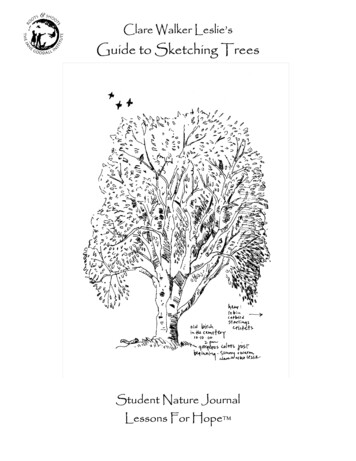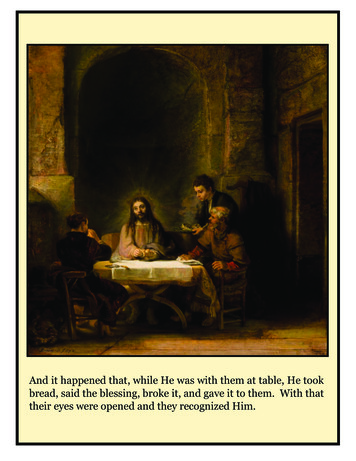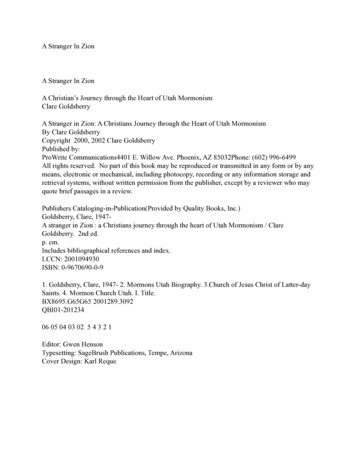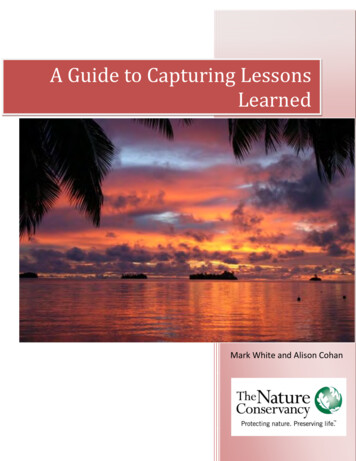
Transcription
Clare Walker Leslie’sGuide to Sketching TreesStudent Nature JournalLessons For Hope
IntroductionThis journal will help you to draw trees. You will find directions for drawing blind and modified contours,and deciduous and evergreen trees (see glossary for definitions). For each type of tree there is acorresponding blank page that can be used as a template for your drawings. When choosing a location forthe activity, it will be helpful to find a tree far enough away from you to see the entire silhouette. Try to beas accurate as possible, and remember to observe, create and have fun! If at any time the type of drawingexercise seems too hard or confusing, feel free to copy Clare’s drawings. Remember, this is how themasters learn to draw!Blind Contour ExerciseClare’s TreeStudent’s TreeTree with leavesTree with no leavesSource: Jacqueline Little1
Blind Contour of et:Moon Phase:Habitat Conditions: Blind contours aredrawn using onecontinuous line,without ever lookingat your paper. Don’t peek until you arethrough the whole treeleaves, branches, etc. Use scrap paper foradditional drawings.Modified Contour of Tree Modified contours aredrawn using onecontinuous line,but you are allowed tolook at your paper. These exercises arefor SEEING trees,not for making‘Good drawings!’ Shareyour drawings with eachother and laugh. But alsolook for how well you havedescribed your tree!2
The BasicsTree SilhouetteTrees come in different shapes.Note the basic shape of the treecrown and forking of the branches.Drawing Tree LimbsBranches grow out fromthe trunk, getting thinnerand thinner until they finallybecome twigs to hold leaves.Drawing Leaves1. Draw mid vein first.2 & 3. Draw leaf outline.4. Fill in the side veins.Source: Clare Walker Leslie3
The BasicsTree SilhouetteDraw silhouette of your tree.Note the basic shape of the tree crownand forking of the branches.Drawing Tree LimbsDraw forking of branches.Remember, branches grow outfrom the trunk, getting thinnerand thinner until finally becometwigs to hold leaves.Drawing Leaves1. Draw mid vein first.2 & 3. Draw leaf outline.4. Fill in the side veins.4
Summer/Fall Deciduous Tree ExerciseSource: Clare Walker Leslie5
Summer/Fall Deciduous et:Moon phase:Habitat Conditions:1. Keep your drawing5. Draw in canopy, as ifno bigger than 6 x 8.cutting tree from sky.Mark edges as inClare’s drawing.2. Begin atbase, as treecurves upfrom roots.3. Carefully seehow tall trunk is.6. Put inbranch clustersIf they appearthrough canopy.4. Draw majorbranchseparations.7. Are leavesjagged or round?8. Draw individualleaf and seedand label. Recordevidence ofanimal activity.6
Winter/Spring Deciduous Tree ExerciseSource: Clare Walker Leslie, Keeping a Nature Journal7
Winter/Spring Deciduous et:Moon phase:Habitat Conditions:1. Keep your drawingno bigger than 6 x 8.5. Notice directionMark in edges as inof branches.Clare’s drawing. Youcan make a box ifyou want.2. Begin atbase, as treecurves upfrom roots.6. Draw roots,they reflect thecanopy shape.3. Carefully seehow tall trunk is.7. Look at drawingfor additional tips.4. Draw majorbranchseparations.8
Evergreen Tree ExerciseSource: Clare Walker Leslie9
Evergreen et:Moon phase:Habitat Conditions:1. Keep your drawingno bigger than 6 x 8.Mark in edges as inClare’s drawing.2. Start at top;work aroundouter shape.3. Fill inneedle details.4. Blind contourof pine cone.10
Roots & Shoots Tree ExerciseNow that you have practiced sketching trees you are ready to chose and draw a tree that most representswho you are! Be sure to use your imagination and include the root structure underneath the ground.Leave enough space in the roots to label the people who support you and in the branches to label yourhopes and dreams. Review Roots & Shoots Tree Exercise in Lessons For Hope.www.lessonsforhope.org/student/Unit1/unitone activity1.aspDr. Jane’s Roots & Shoots TreeSource: Dr. Jane Goodall11
12
Extension ActivitySource: Clare Walker Leslie, Keeping a Nature Journal13
GlossaryBlind Contour A sketch which is drawn using one continuous line, without looking at your paper.Canopy The outline of an individual’s tree shape, comprising the leaves and branches.Deciduous Tree Trees that have leaves that fall off each autumn to save water loss in winter and toprevent extra weight in ice or snow storms.Evergreen A tree which is in leaf throughout the year. Semi-evergreen is a tree which loses someof its leaves in autumn, retaining some until new leaves form in the spring.Habitat Conditions Ongoing conditions, such as a drought or long periods of rain.Modified Contour A sketch which is drawn using one continuous line, looking at your paperoccasionally.Shrub A tree which has more than one trunk.ResourcesThe Jane Goodall Institute. www.janegoodall.orgLessons For Hope. www.lessonsforhope.orgLessons For Hope is a web-based curriculum writtenby the Jane Goodall Institute. High school students learn about Dr. Jane Goodall’s life andexplore the sources of her optimism and hope for the future. Activities are designed to empowerstudents to make a positive contribution in their community.Roots & Shoots. www.janegoodall.org/rs/index.htmlRoots & Shoots is the Jane GoodallInstitute’s environmental and humanitarian program for youth.You can find the following resources and other good books about drawing and nature at your school, locallibrary, and bookstores.Leslie, C.W. and Roth, C. Keeping a Nature Journal: Discover aWhole New Way of Seeing theWorld Around You. North Adams, Massachusetts, Storey Books, 2000.Leslie, Clare W. Nature All Year Long. Dubuque, Iowa, Kendall/Hunt Publishing Company, 2002.CreditsEditors: Susan Frey, Director of Education, Roots & ShootsStacy Wolff, Roots & Shoots Education InternSpecial thanks to Clare Walker Leslie whose drawings and expertise in the area of nature journaling wasinstrumental in the design of this pamphlet. As an artist, educator and naturalist, she draws inspiration fromnature and uses her talents to help others develop skills in observation and sketching. She accomplishesher goal of encouraging and enhancing our appreciation for nature through teaching and the publication ofsix books. To learn more about Clare Walker Leslie, visit www.clarewalkerleslie.com14
Draw silhouette of your tree. Note the basic shape of the tree crown and forking of the branches. Drawing Tree Limbs Draw forking of branches. Remember, branches grow out from the trunk, getting thinner and thinner until finally become twigs to hold leaves. Drawing Leaves 1. Draw mid vein first. 2 & 3.










